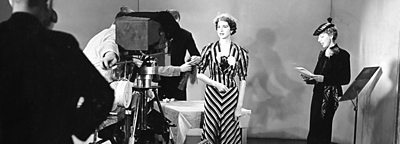The 'money to develop it' would come from the sale of television sets (or as Baird called them 'Televisors'). However, there was a major snag. In order to sell the sets you have to have programmes to watch - a television service. Baird built a television studio in Long Acre (Covent Garden) and experimented with a small transmitter, but he soon realised that he needed a much more powerful transmitter to broadcast his programmes.
The 大象传媒 had such a transmitter, called 2LO, situated on the roof of Selfridges in London. 2LO was used for daily 'wireless' programmes, but the 大象传媒 service closed down in the evening at about 11pm and often did not re-start until mid-morning. So Baird approached the 大象传媒 for permission to use the transmitter during these periods.
Eventually the 大象传媒 reluctantly agreed and by the end of 1929 Baird was running a programme of regular television broadcasts which would continue for the next six years. Unfortunately, at first the 大象传媒 only had the one transmitter (for television you need two; one for the picture and one for the sound). It meant that for the first six months, television programmes comprised two minutes of picture, followed by two minutes of sound and so on.
By March 1930 the 大象传媒 had opened a second radio transmitter, and so simultaneous sound and picture transmissions began. Three months later Baird televised the first play to be transmitted on television in this country - Pirandello's The Man with a Flower in his Mouth.

Produced by the 大象传媒's Lance Sieveking, the play had been chosen because it only had three characters, plenty of long speeches and very little action. The actors, daubed with a strange blue and yellow make-up to compensate for deficiencies in the camera system, took turns to slide into a fixed seat in front of the camera, which could only show one head at a time.
Internal 大象传媒 memo
-
A senior member of staff is unimpressed after viewing a demonstration of the early Baird system in 1928.
